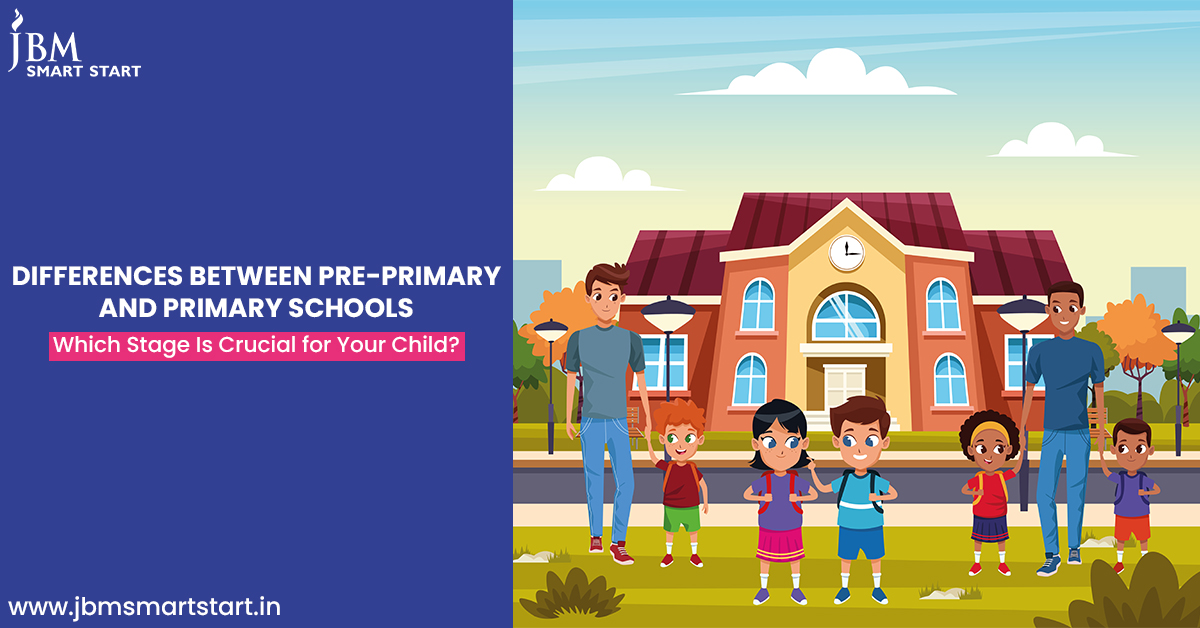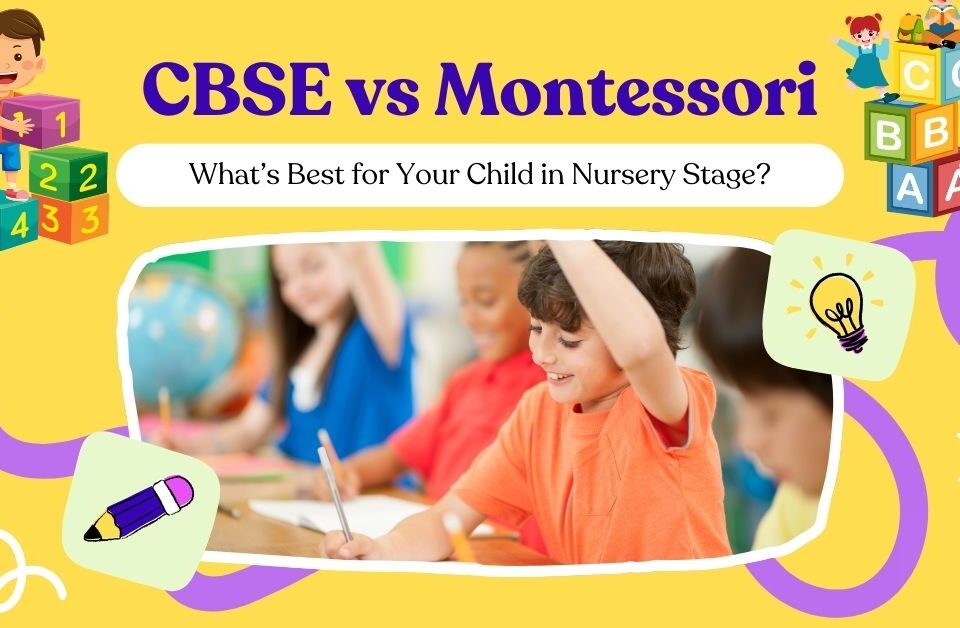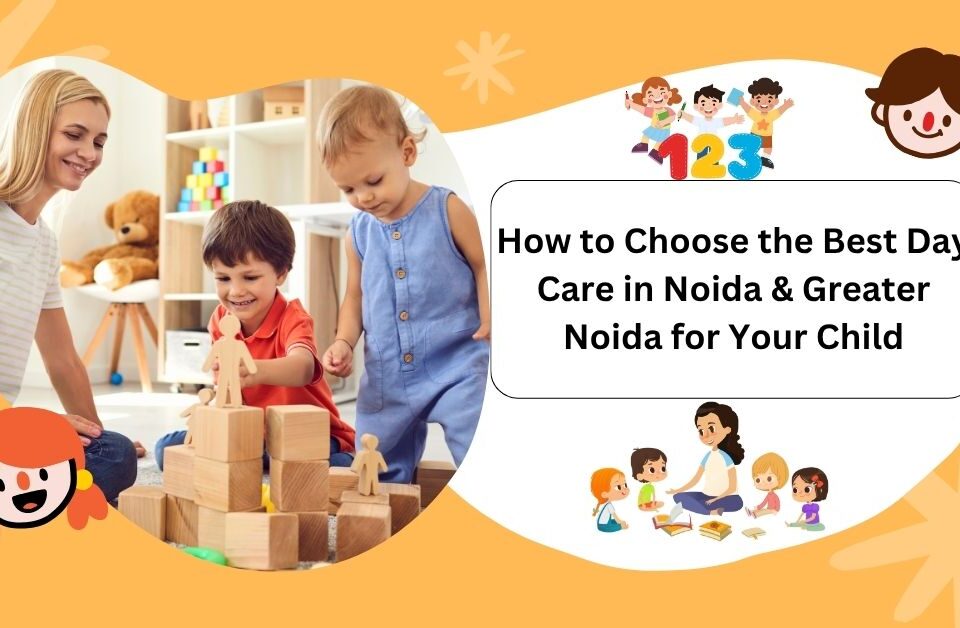
Best Pre-Primary School in Greater Noida: A Parent’s Guide
December 24, 2024
15 Fun and Simple Art Activities for Preschoolers to Inspire Creativity
January 21, 2025Differences Between Pre-Primary and Primary Schools: Which Stage Is Crucial for Your Child?
Understanding the Importance of Early Education: Pre-Primary vs Primary Schools
The early years of education play a significant role in a child’s growth. This is because it shapes their personality, learning abilities, and social skills. However, parents often find themselves comparing pre-primary vs primary school to determine which stage is more important. Both stages have distinct roles in a child’s development. If parents understand the differences between pre-primary and primary schools, it will help them make informed decisions.
If you compare primary vs pre-primary school, the latter focuses on developing curiosity, creativity, and emotional intelligence through play-based activities. On the other hand, primary school shifts attention to academics, discipline, and subject-specific learning.
For better understanding, this blog explains the top differences between these two phases and highlights their significance in a child’s educational journey.
Top 8 Key Differences Between Pre-Primary and Primary Schools
1: Age Groups and Developmental Goals: Pre-Primary vs. Primary
The first key point in the pre-primary vs primary school comparison is the age group of both stages.
Pre-primary classes are designed for children aged 2 to 6 years because they mainly focus on early childhood development. Pre-primary means preparing children for formal schooling by developing their motor skills, language abilities, and social interactions.
On the other hand, primary school accommodates children aged 6 to 12 years and focuses on structured learning. The primary school meaning emphasises academic development, discipline, and logical thinking. These form the foundation for higher education.
2: Curriculum Focus: Playful Learning vs. Structured Academics
If we’re discussing what is pre-primary education, it actually refers to the teaching of basic concepts like colours, shapes, numbers, and letters using playful activities. It emphasises hands-on learning and storytelling to build curiosity and imagination.
Meanwhile, what is primary education? It involves a more structured curriculum that focuses on core subjects such as mathematics, science, and languages.
The goal is to develop comprehension, critical thinking, and subject mastery in this stage. It prepares children for advanced studies.
3: Learning Environments: Flexible Exploration vs. Structured Discipline
The learning environment in pre-primary education is relaxed and flexible. This is because its classrooms encourage free play, creativity, and exploration.
Thus, one of the differences between pre-primary and primary schools is that the former creates a supportive space for emotional and social growth. Teachers focus on engaging children with visual aids, songs, and group activities to make learning fun.
In contrast, primary school provides a structured setting with defined schedules, homework, and classroom rules. This environment promotes discipline, responsibility, and focus. Hence, this stage is responsible for preparing students for academic challenges and future goals.
4: Teaching Methods: Activity-Based Learning vs. Formal Instruction
A major aspect of the differences between pre-primary and primary schools is the teaching approach.
Pre-primary education focuses on activity-based learning methods such as puzzles, games, and storytelling. These techniques aim to develop creativity, motor skills, and problem-solving abilities.
However, between primary vs pre-primary school, the former’s teaching methods become more formal and involve textbooks, lectures, and written assignments.
This stage prioritises strengthening analytical thinking, comprehension, and teamwork through structured lessons and projects.
5: Fostering Emotional and Social Skills at Every Stage
In pre-primary classes, children are encouraged to develop social and emotional skills through group activities, sharing, and communication. This phase teaches teamwork, confidence, and emotional expression which are essential for healthy relationships.
On the other hand, primary education builds on these skills by developing independence, leadership, and resilience. Children are taught how to handle responsibilities, solve problems, and collaborate with peers. This ensures well-rounded development.
6: Cognitive Skills Development: Building Creativity and Logic
Pre-primary means stimulating cognitive growth through visual aids, storytelling, and hands-on activities. These methods encourage imagination, creativity, and memory while keeping children engaged in the learning process.
Primary school, however, sharpens logical reasoning, analytical thinking, and comprehension. The focus shifts to strengthening cognitive abilities through structured subjects and problem-solving exercises.
7: Assessment Techniques: Informal Observations vs. Formal Tests
There are no formal tests for kids in pre-primary school. Instead, assessments are informal and observation-based. Teachers evaluate children based on their participation, behaviour, and creativity during activities. Thus, it helps to build a stress-free learning experience.
However, in primary school, assessments are more formal and structured that include tests, quizzes, and assignments. These evaluations measure academic growth and help identify areas that need improvement. They provide a clear roadmap for a child’s progress.
8: Preparing for the Future: Confidence vs. Academic Foundations
Parents often wonder what is pre-primary and its importance in preparing children for formal schooling. Pre-primary education builds confidence, adaptability, and curiosity. It helps children to transition smoothly to a structured learning environment.
Primary education, on the other hand, focuses on strengthening academic foundations and developing study habits, time management, and discipline. It prepares children for higher education.
Conclusion: Why Both Pre-Primary and Primary Education Are Crucial for Your Child’s Success
The differences between pre-primary and primary schools highlight how each stage serves a unique purpose in a child’s growth. Pre-primary education encourages emotional development, social skills, creativity, and exploration.
On the other hand, between pre-primary vs primary school, the latter focuses on academics and structured learning to develop discipline and logical thinking.
Instead of viewing primary school vs pre-primary as competing stages, parents should see them as complementary phases that together create a strong foundation for lifelong learning.
Both stages are equally important for setting the right path toward academic success and personal development for a child.
Set the foundation for your child’s bright future with JBM Smart Start, the best preschool in Greater Noida! From engaging pre-primary classes that encourage creativity and social skills to structured primary education that builds academic excellence, our programs are designed to support every stage of your child’s growth. Enrol your child at JBM Smart Start today and discover the perfect learning environment for your little one!
FAQs About Pre-Primary and Primary Education:
Q1: What is the difference between pre-primary and primary schools?
Ans: The difference between pre-primary and primary schools lies in their focus and structure. Pre-primary education emphasises play-based learning, creativity, and social development. However, primary school focuses on academic subjects, discipline, and logical thinking to prepare children for higher education.
Q2: At what age does preschool start in India?
Ans: In India, pre-primary classes typically begin at the age of 2.5 to 3 years. Children usually complete pre-primary education by the age of 6 before transitioning to primary school which starts from Class 1.
Q3: Which class is called pre-primary?
Ans: Pre-primary means early education programs that include nursery, kindergarten (LKG and UKG), and preparatory classes. These stages focus on building basic skills in language, math, and social interaction.
Q4: Which stage is more crucial: pre-primary or primary education?
Ans: Both pre-primary and primary education are crucial for a child’s growth. The pre-primary school encourages creativity and emotional development. On the other hand, primary school builds academic foundations and discipline. Hence, each stage is equally important for the overall development of your child.
Q5: How can parents choose the right preschool for their child?
Ans: Parents should look for a pre-primary school that offers a safe and engaging environment with experienced teachers. A good pre-primary education program encourages play-based learning, social interaction, and emotional growth, and ensures a smooth transition to primary school.




